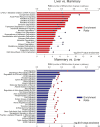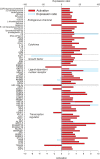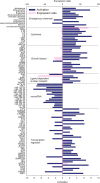Transcriptome difference and potential crosstalk between liver and mammary tissue in mid-lactation primiparous dairy cows
- PMID: 28291785
- PMCID: PMC5349457
- DOI: 10.1371/journal.pone.0173082
Transcriptome difference and potential crosstalk between liver and mammary tissue in mid-lactation primiparous dairy cows
Abstract
Liver and mammary gland are among the most important organs during lactation in dairy cows. With the purpose of understanding both the different and the complementary roles and the crosstalk of those two organs during lactation, a transcriptome analysis was performed on liver and mammary tissues of 10 primiparous dairy cows in mid-lactation. The analysis was performed using a 4×44K Bovine Agilent microarray chip. The transcriptome difference between the two tissues was analyzed using SAS JMP Genomics using ANOVA with a false discovery rate correction (FDR). The analysis uncovered >9,000 genes differentially expressed (DEG) between the two tissues with a FDR<0.001. The functional analysis of the DEG uncovered a larger metabolic (especially related to lipid) and inflammatory response capacity in liver compared with mammary tissue while the mammary tissue had a larger protein synthesis and secretion, proliferation/differentiation, signaling, and innate immune system capacity compared with the liver. A plethora of endogenous compounds, cytokines, and transcription factors were estimated to control the DEG between the two tissues. Compared with mammary tissue, the liver transcriptome appeared to be under control of a large array of ligand-dependent nuclear receptors and, among endogenous chemical, fatty acids and bacteria-derived compounds. Compared with liver, the transcriptome of the mammary tissue was potentially under control of a large number of growth factors and miRNA. The in silico crosstalk analysis between the two tissues revealed an overall large communication with a reciprocal control of lipid metabolism, innate immune system adaptation, and proliferation/differentiation. In summary the transcriptome analysis confirmed prior known differences between liver and mammary tissue, especially considering the indication of a larger metabolic activity in liver compared with the mammary tissue and the larger protein synthesis, communication, and proliferative capacity in mammary tissue compared with the liver. Relatively novel is the indication by the data that the transcriptome of the liver is highly regulated by dietary and bacteria-related compounds while the mammary transcriptome is more under control of hormones, growth factors, and miRNA. A large crosstalk between the two tissues with a reciprocal control of metabolism and innate immune-adaptation was indicated by the network analysis that allowed uncovering previously unknown crosstalk between liver and mammary tissue for several signaling molecules.
Conflict of interest statement
Figures







Similar articles
-
The Impact of Intramammary Escherichia coli Challenge on Liver and Mammary Transcriptome and Cross-Talk in Dairy Cows during Early Lactation Using RNAseq.PLoS One. 2016 Jun 23;11(6):e0157480. doi: 10.1371/journal.pone.0157480. eCollection 2016. PLoS One. 2016. PMID: 27336699 Free PMC article.
-
Supplements of vitamins B9 and B12 affect hepatic and mammary gland gene expression profiles in lactating dairy cows.BMC Genomics. 2016 Aug 15;17(1):640. doi: 10.1186/s12864-016-2872-2. BMC Genomics. 2016. PMID: 27526683 Free PMC article.
-
Short Time-Series Expression Transcriptome Data Reveal the Gene Expression Patterns of Dairy Cow Mammary Gland as Milk Yield Decreased Process.Genes (Basel). 2021 Jun 20;12(6):942. doi: 10.3390/genes12060942. Genes (Basel). 2021. PMID: 34203058 Free PMC article.
-
Effects of short day photoperiod on prolactin signaling in dry cows: a common mechanism among tissues and environments?J Anim Sci. 2008 Mar;86(13 Suppl):10-4. doi: 10.2527/jas.2007-0311. Epub 2007 Aug 8. J Anim Sci. 2008. PMID: 17686892 Review.
-
A 100-Year Review: Mammary development and lactation.J Dairy Sci. 2017 Dec;100(12):10332-10352. doi: 10.3168/jds.2017-12983. J Dairy Sci. 2017. PMID: 29153168 Review.
Cited by
-
PRL/microRNA-183/IRS1 Pathway Regulates Milk Fat Metabolism in Cow Mammary Epithelial Cells.Genes (Basel). 2020 Feb 13;11(2):196. doi: 10.3390/genes11020196. Genes (Basel). 2020. PMID: 32069836 Free PMC article.
-
Hepatic Transcriptome Reveals Potential Key Genes Contributing to Differential Milk Production.Genes (Basel). 2024 Sep 20;15(9):1229. doi: 10.3390/genes15091229. Genes (Basel). 2024. PMID: 39336820 Free PMC article.
-
MiRNA-Seq reveals key MicroRNAs involved in fat metabolism of sheep liver.Front Genet. 2023 Mar 9;14:985764. doi: 10.3389/fgene.2023.985764. eCollection 2023. Front Genet. 2023. PMID: 36968587 Free PMC article.
-
Identification of candidate genes for milk production traits by RNA sequencing on bovine liver at different lactation stages.BMC Genet. 2020 Jul 9;21(1):72. doi: 10.1186/s12863-020-00882-y. BMC Genet. 2020. PMID: 32646377 Free PMC article.
-
Transcriptomic regulations of heat stress response in the liver of lactating dairy cows.BMC Genomics. 2023 Jul 20;24(1):410. doi: 10.1186/s12864-023-09484-1. BMC Genomics. 2023. PMID: 37474909 Free PMC article.
References
-
- Schingoethe DJ, Byers FM, Schelling GT (1988) Nutrient needs during critical periods of the life cycle In: Church D, editor. The Ruminant Animal: Digestive, Physiology, and Nutrition. Illinois, USA: Waveland Press Inc. pp. 421–447.
-
- Kuhn C, Freyer G, Weikard R, Goldammer T, Schwerin M (1999) Detection of QTL for milk production traits in cattle by application of a specifically developed marker map of BTA6. Anim Genet 30, 333–340. - PubMed
-
- Bergman EN, Brockman RP, Kaufman CF (1974) Glucose-Metabolism in Ruminants—Comparison of Whole-Body Turnover with Production by Gut, Liver, and Kidneys. Federation Proceedings 33, 1849–1854. - PubMed
MeSH terms
LinkOut - more resources
Full Text Sources
Other Literature Sources
Molecular Biology Databases

